2016年广西民族大学中国音乐史考研真题A卷
广西民族大学616民族学通论历年考研真题2016-2020
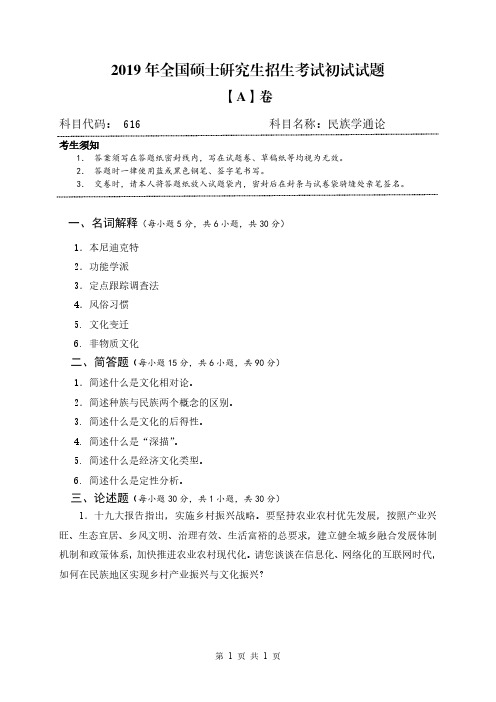
2019年全国硕士研究生招生考试初试试题
【A】卷
科目代码:616科目名称:民族学通论
考生须知
1.答案须写在答题纸密封线内,写在试题卷、草稿纸等均视为无效。
2.答题时一律使用蓝或黑色钢笔、签字笔书写。
3.交卷时,请本人将答题纸放入试题袋内,密封后在封条与试卷袋骑缝处亲笔签名。
一、名词解释(每小题5分,共6小题,共30分)
1.本尼迪克特
2.功能学派
3.定点跟踪调查法
4.风俗习惯
5.文化变迁
6.非物质文化
二、简答题(每小题15分,共6小题,共90分)
1.简述什么是文化相对论。
2.简述种族与民族两个概念的区别。
3.简述什么是文化的后得性。
4.简述什么是“深描”。
5.简述什么是经济文化类型。
6.简述什么是定性分析。
三、论述题(每小题30分,共1小题,共30分)
1.十九大报告指出,实施乡村振兴战略。
要坚持农业农村优先发展,按照产业兴旺、生态宜居、乡风文明、治理有效、生活富裕的总要求,建立健全城乡融合发展体制机制和政策体系,加快推进农业农村现代化。
请您谈谈在信息化、网络化的互联网时代,如何在民族地区实现乡村产业振兴与文化振兴?
第1页共1页。
2016年广西民族大学考研真题810 英语教学论A卷
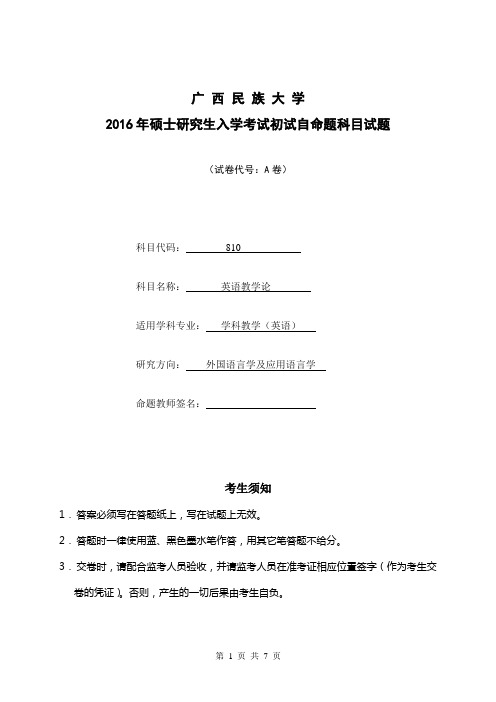
广西民族大学2016年硕士研究生入学考试初试自命题科目试题(试卷代号:A卷)科目代码:810科目名称:英语教学论适用学科专业:学科教学(英语)研究方向:外国语言学及应用语言学命题教师签名:考生须知1.答案必须写在答题纸上,写在试题上无效。
2.答题时一律使用蓝、黑色墨水笔作答,用其它笔答题不给分。
3.交卷时,请配合监考人员验收,并请监考人员在准考证相应位置签字(作为考生交卷的凭证)。
否则,产生的一切后果由考生自负。
I. There are 12 incomplete statements and 8 questions in this part. Each statement or question has four answers marked A, B, C and D. Read the choices carefully and choose the one which can best complete the statement or answer the question and then write your answers on the Answer Sheet. (30 points, 1.5 points for each)1. Chomsky believes that linguistic study and research can help explain what happens inthe mind, and linguistics should be regarded as a branch ofA. methodologyB. psychologyC. sociologyD. anthropology2. Generally speaking, the Grammar-translation Method belongs to the school oflinguistics.A. appliedB. modernC. traditionalD. behaviourist3. The neogrammarians, represented by Hermann Paul, formed the main linguistic base ofA. the Grammar-Translation MethodB. the Direct MethodC. the Oral ApproachD. the Audiolingual Method4. The Oral Approach/Situational Language Teaching believes in a theory of learningthe language is based on a type of theory.A. behaviorist habit formationB. structural linguisticsB. cognitive psychology D. functional linguistics5. The Natural Approach sees the language acquirer as a of comprehensible input.A. receiverB. producerC. processorD. acquirer6. The Audiolingual Method insists on accurate reproduction of sentence patterns andtheir attitude towards s tudents’ language error isA. positiveB. negativeC. passiveD. active7. The monitor theory, which is very popular among foreign language teachersin , was put forward by Stephen Krashen in the late 1970s.A. ChinaB. FranceC. BritainD. America8. James Asher was the founder ofA. the Direct MethodB. the Cognitive ApproachC. Total Physical ResponseD. suggestopaedia9. With regard to syllabus design, the Communicative approach emphasizesA. communicationB. expressing of meaningC. teacher’s skillsD. learners’ needs10. The Cognitive Approach believes that play a decisive role in foreignlanguage learning.A. the teacherB. the studentsC. the materialsD. the environment11. English teaching in China didn’t enter into the formal educational systemuntil the ______ century.A. late 19thB. early 20thC. mid-20thD. late 20th12. The generative linguist is interested not only in ______ language but also inexplaining language.A. teachingB. describingC. usingD. understanding13. Which role does the teacher play in the following activities?When answering the teacher’question, if a student doesn’t seem to be ready for an answer, the teacher gives hints.A. controllerB. participantC. assessorD. prompter14. In teaching grammar, what stage can the teacher use for following activity?The teacher asks the students to produce sentences based on the pictures provided.A. presentationB. practiceC. applicationD. production15. Which reading skill is the teacher using in teaching reading?The teacher asks the students to try to guess information or ideas that go beyond the literal meaning of the text.A.inferring or reading between the linesB.recognizing organization of the textC.predictingD.scanning16. How is the following activity organized?The teacher asks all the students to do completion exercises.A. pair workB. whole-class workC. individualD. group work17. In teaching vocabulary, what stage is most suitable for the following activityThe teacher uses word formation rules and common affixes to buildnew lexical knowledge.A. presentationB. productionC. practiceD. B & C18. What technique is the teacher using in teaching writing?Students editing of each others’ writingsA. conferencingB. peer-editingC. RevisingD. self-editing19. What activity the teacher is doing?The teacher gives the first half of the dialogue by asking a question:(The teacher holds on a picture with a person reading a book)T: what were you doing when I called you last night?S: I was reading a book when you called.A. controlled activity B Semi-controlled activityC. commutative activityD. free activity20. Which type of approach can best describe the following learning pattern?Discussion about how to solve certain problemsA.autonomous learningB.interactive learningC.contextualized learningD.task-based learningII. Decided whether the following statements are true (T) or false (F).Write your answers on the Answer Sheet. (10 points, 1 point for each)1. As a teaching technique, the Grammar-translation Method teaches grammar inductively.2. The Direct Method emphasizes the importance of spoken language, therefore holds that reading and writing should be taught only after speaking.3. According to the Inductive Way Grammar Teaching, the grammar rules should be worked out by the students themselves from examples without explicit explanation from the teacher.4. In Cognitive Approach, second language acquisition is viewed as the acquisition of knowledge, involving cognitive representations that regulate and guide internal performance.5. In Communicative Approach teacher is viewed as the authority of the classroom.6. Emphasis on learning to communicate in the target language is one of the main features of The Communicative Approach.7. According to Krashen, language learning comes about through using target language communicatively, rather than through practicing language skills.8. According to Skinner, reward was much more effective than punishment ina teaching situation.9. Classroom instructions refer to the type of language teachers use to organize or guide learning10. Assessme nt often takes the ‘pencil and paper’ form and it is only done at the end ofa learning period.III. Filling in the blanks. Write your answers on the Answer Sheet (40 points, 2 points for each)1. In Krashens Monitor Mode of second language development, there are two distinct processes, one is acquisition, and the other is ..2. , a linguist in America, is regarded as the father of American structuralism.3. An ultimate purpose of learning a foreign language in a Grammar-Translation classroom if to enable the learners to its literature.4. Ideally Lesson planning should be done at two levels: and micro planning.5. The three models for teaching reading are: , top-down and interactive model.6. The Audiolingual Method uses dialogues as the main form of language presentationand as the main training techniques.7. The Cognitive Approach believes that language learning is a process whichinvolves and not simply the forming of habits.8. The is the center of Krashen’s second language learning theory.9. According to Hedge, communicative competence includes linguistic competence, pragmatic competence, , strategic competence and fluency.10. The teacher plays an role in Total Physical Response.11. A typical task-based Language Teaching procedure usually consists of three stages:Pre-task, Task cycle and .12. In teaching grammar, mechanical practice is mainly used to help the learners tomaster accurately.13. Scanning is a type of pre-reading activity, which means to read to locate specific.14. The main procedures of process writing include creating a motivation to write, brainstorming, mapping, freewriting, outlining, drafting, revising and conferencing.15. A PPP model refers to Presentation, and Production.16. The general aim of the Communicative Approach is to develop the students’ .17. Tactile learners learn more effectively through .18. There are two methods of assessment: and formative assessment.19. In practicing language skills, controlled activities mainly focus onaccuracy.20. The functional view of linguistic not only sees language as a linguistic system but also afor doing thingsIV. Answer the following questions. Write your answers on the Answer Sheet (40 points, 8 points for each)1.What are mechanical practice and meaningful practice in grammar teaching? In order toteach grammar effectively, how to use these two practices?2.What roles do you think a teacher should play in the classroom? State your reasons.3. How do you understand the relationship between the grammatical forms of a languageand their communicative functions?4.What rules do you think a teacher should follow in order to make classroom instructioneffective?5.What are the objectives of the pre-reading stages of teaching reading and what techniquescan be employed to fulfill these objectives?V. Lesson designing (30 points)Directions: In this part, you are to design a 40-minute writing lesson according to the information provided.Information: Type of the lesson: writingStudent level: 40 junior middle school students, Grade 8Lesson duration: 40 minutesThe Aim of the lesson: By the end of the lesson, students will be able to write a100-word passage describing a person in terms of: appearance, personality andhobbies.Your answer should include:1. A lesson plan which includes:1)Teaching objectives ( at least 3 objectives, 6 points , 2 points for each )2)Teaching important and difficult points (4 points, 2 points for each )3)Teaching aids (3 points)4)Teaching procedures ( at least 3 steps, 9 points, 3 points for each)2.Predicted problems and solutions (8 points, 4 points for each)。
2016年广西民族大学法国文学与文化考研真题A卷

2016年广西民族大学法国文学与文化考研真题A卷考生须知1.答案必须写在答题纸上,写在试题上无效。
2.答题时一律使用蓝、黑色墨水笔作答,用其它笔答题不给分。
3.交卷时,请配合监考人员验收,并请监考人员在准考证相应位置签字(作为考生交卷的凭证)。
否则,产生的一切后果由考生自负。
I.Expliquez les termes suivants(每小题7分,共6小题,共42分):1)Renaissance;2)Classicisme;3)Le siècle des Lumières;4)Le nouveau roman;5)Madame Bovary;6)François HollandeII. Analysez le texte et répondez aux questions(前三小题30分,第四题20分,共50分):Signifiant et signifiéIl est possible de saisir objectivement dans Racine le fonctionnement de l’institution littéraire; il est impossible de prétendre à la même objectivitélorsqu’on veut surprendre en lui le fonctionnement de la création. C’est une autre logique, ce sont d’autres exigences, une autre responsabilité; il s’agit d’interpréter le rapport d’une oeuvre et d’un individu; comment le faire san se référer à une psychologie? Et comment cette psychologie pourrait-elle autre chose que choisie par le critique? Bref, toute critique de la création littéraire, si objective, si partielle qu’elle se prétendre, ne peut être que systématique. Il n’y a pas a s’en plaindre mais seulement à demander la franchise du système.1)Expliquez les deux termes: Signifiant et signifié2)Quel but est-ce que Roland Barthes veut atteindre par introduire ces deux notionsdans sa critique littéraire?3)Quelles sont les marques de la critique structuraliste?4)Résumez et commnetez le texte.III. Répondez aux questions suivantes(第一小题30分,第二小题28分,共2小题,共58分):1)Comment est ce-que Stendhal dramatise la scène où se déroule l’actionde l’histoire?2)试析莫里哀喜剧《伪君子》的思想内容和艺术特点(中文答题)。
2016年广西民族大学教育科学研究方法考研真题A卷
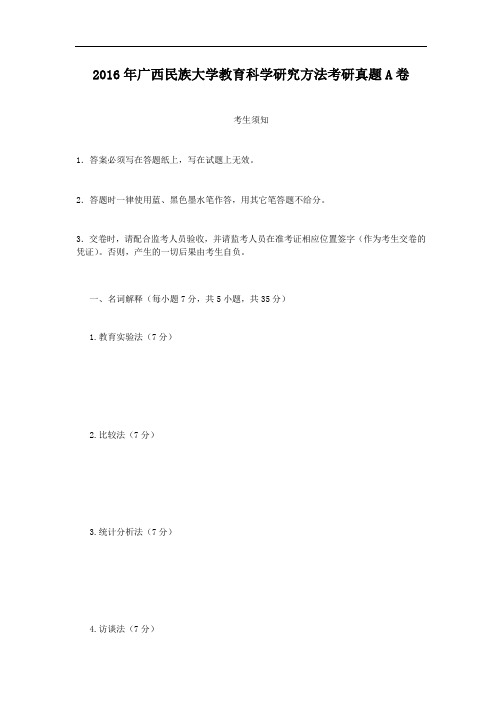
2016年广西民族大学教育科学研究方法考研真题A卷
考生须知
1.答案必须写在答题纸上,写在试题上无效。
2.答题时一律使用蓝、黑色墨水笔作答,用其它笔答题不给分。
3.交卷时,请配合监考人员验收,并请监考人员在准考证相应位置签字(作为考生交卷的凭证)。
否则,产生的一切后果由考生自负。
一、名词解释(每小题7分,共5小题,共35分)
1.教育实验法(7分)
2.比较法(7分)
3.统计分析法(7分)
4.访谈法(7分)
5.简单随机抽样(7分)
二、简答题(每小题20分,共4小题,共80分)
1.教育研究有哪些特点?(20分)
2.教育研究问题的来源有哪些?(20分)
3.运用抽样,需要注意哪些问题?(20分)
4.观察法有哪些特点?(20分)
三、综合应用题(35分)
自拟一个调查课题,编制一份简单的问卷。
具体要求:
(1)问卷中不少于6个题目;
(2)至少有两种问题形式。
2016年广西民族大学考研真题现代科技概论
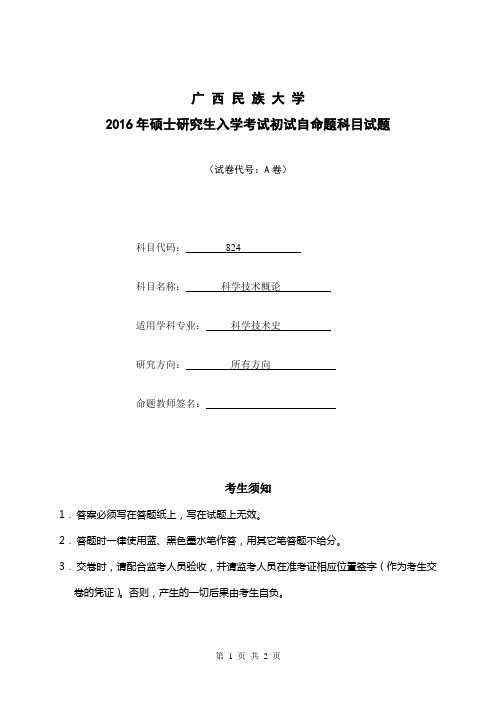
广西民族大学
2016年硕士研究生入学考试初试自命题科目试题
(试卷代号:A卷)
科目代码:824
科目名称:科学技术概论
适用学科专业:科学技术史
研究方向:所有方向
命题教师签名:
考生须知
1.答案必须写在答题纸上,写在试题上无效。
2.答题时一律使用蓝、黑色墨水笔作答,用其它笔答题不给分。
3.交卷时,请配合监考人员验收,并请监考人员在准考证相应位置签字(作为考生交卷的凭证)。
否则,产生的一切后果由考生自负。
一、名词解释(每小题5分,共6小题,共30分)
1.能量守恒定律
2.紫外灾难
3.熵
4.克隆技术
5.维萨里
6.发酵工程
二、简答题(每小题15分,共4小题,共60分)
1.简述道尔顿原子论的基本观点。
2.简述牛顿主要科学成就。
3.简述元素周期律的发现过程。
4.达尔文进化论的主要内容。
三、论述题(每小题30分,共2小题,共60分)
1.第二次产业革命中德国科学技术发展的主要成就。
2.随着科学技术的快速发展,可持续性发展已成为世界性的共识。
请论述当今中国社会发展中所面临的新的问题,以及在可持续性发展理论的引导下,如何使现代科学技术获得更合理利用与发展。
2016年广西民族大学民族经济学考研真题A卷
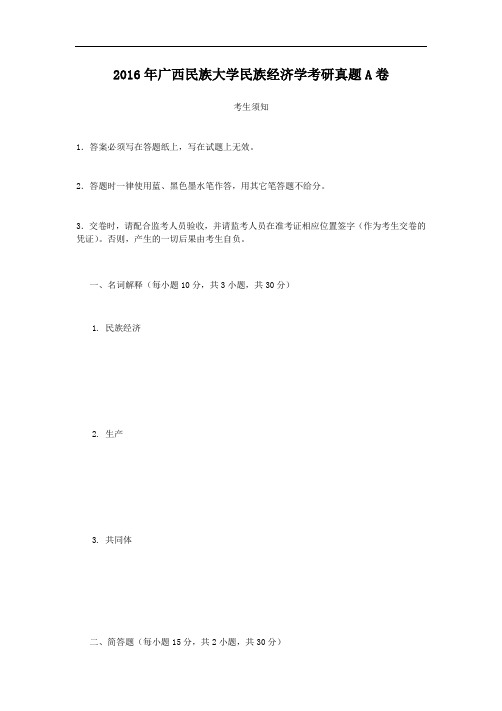
2016年广西民族大学民族经济学考研真题A卷
考生须知
1.答案必须写在答题纸上,写在试题上无效。
2.答题时一律使用蓝、黑色墨水笔作答,用其它笔答题不给分。
3.交卷时,请配合监考人员验收,并请监考人员在准考证相应位置签字(作为考生交卷的凭证)。
否则,产生的一切后果由考生自负。
一、名词解释(每小题10分,共3小题,共30分)
1. 民族经济
2. 生产
3. 共同体
二、简答题(每小题15分,共2小题,共30分)
1. 请简述交换的基本要素。
2. 请简述马林诺斯基所著《西太平洋的航海者》一书的主要内容。
三、论述题(每小题25分,共2小题,共50分)
1. 请述“一带一路”战略对我国少数民族地区经济与社会发展的影响。
2. 对于后发展地区而言,发展经济与保护环境往往处于一种两难抉择的境地,请谈谈你对此一问题的看法。
四、分析题(每小题40分,共1小题,共40分)
阅读以下材料,阐述你的理解。
有学者认为,“经济”原本来是指人类社会活动的一种物质活动。
然而,在非市场经济社会中,由于经济总是与其它种种社会因素交织在一起表现出来的,因而它不能成为按一定经济目的所采取的直截了当的、“合理”的行为。
反过来说,这就意味着这些社会中一定的礼仪行为是带有“经济”活动这种功能的。
【研考试题分析】中国音乐学院2016年研究生入学考试《曲式与作品分析》考题简析

【研考试题分析】中国音乐学院2016年研究生入学考试《曲式与作品分析》考题简析又是一度考研季,为考研奋斗了n长时间的莘莘学子日前终于打完了这场艰苦的战役。
对于专业基础课当中的“曲式与作品分析”考试而言,也许是考生最惴惴不安的科目,生怕大结构写错之后“血本无归”。
今年中国音乐学院的《曲式与作品分析》考题是贝多芬《第七钢琴奏鸣曲》(Op.10 No.3)的第二乐章,整体难度不大,但一些细节还是能够考察学生对于知识的灵活运用能力。
全曲结构为奏鸣曲式,下面列出该乐章的图示,个人一家之言,仅供读者参考:文字分析:呈示部:主部为两句结构的平行乐段,调性稳定地建立在d小调上;连接部经历了两个调性,d小调为第一部分,由装饰性短句奏出,与主部形成引申性对比,之后调性转入C大调,并收拢终止;副部也是两句结构的平行乐段,建立在主调的属调a小调上,典型的古典奏鸣曲式调性布局,收拢终止同时进入结束部;结束部很短,仅3个小节,巩固副部的调性。
展开部:本乐章的展开部非常短小,开始以副部主题动机的倒影引入,之后加以展开,而伴奏织体仍与主部相关(三连音),调性建立在F大调上;之后突然出现的三十二分音符以及d小调属音的持续表明了此时进入了过渡阶段。
再现部:主部的前一乐句与呈示部主部相同,但后半句模进,并且开放性的将连接部的材料吸收进来,使得主部与连接部打成一片,形成d小调-降B大调的转调乐段并收拢终止。
副部的材料与规模与呈示部副部相同,只是调性上服从了主调,完满终止后省略了结束部,直接叠入尾声。
尾声:有第二展开部的乐思,分为两部分,第一部分仍是主部动机发展,用于均衡展开部的副部材料(因为中间的展开部太小了,没有主部的展开空间);第二部分有些许副部因素进入,最后用切分的材料作为整个乐章的收尾。
考题分析:该作品作为中国音乐学院2016年的研究生入学考试,难度中等偏易,但细节方面可以测试出考生的水平。
在笔者看来,本题除了测试考生对奏鸣曲式整体的敏感度之外,有三个地方考察能力:第一是展开部开始部分材料的来源,对于非作曲专业的学生来说有一定的难度,但如果本科阶段中对音乐发展手法有系统的讲解的话也应不难;第二是再现部主部与连接部的统一,也许多数考生在平时的讲解中未碰到如此情况,但从无论从材料还是调性来看都非常明显,这是对学生知识迁移能力的考察;第三是尾声的判断与处理,这是考察学生对能否对作曲家音乐材料运用的理解。
2016年广西民族大学汉语基础考研真题A卷
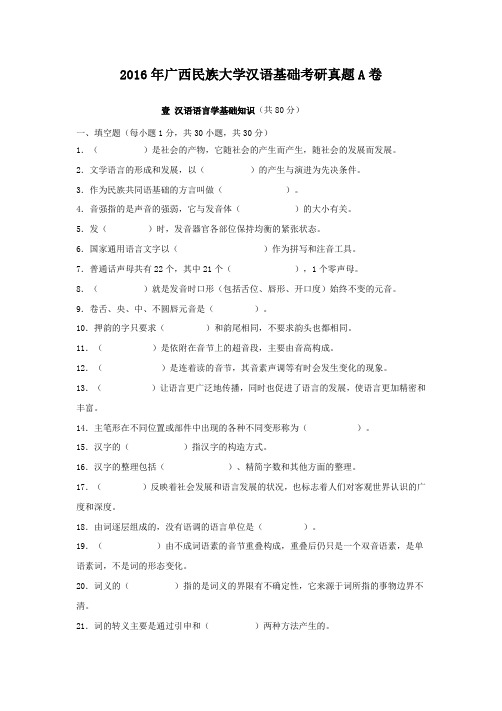
2016年广西民族大学汉语基础考研真题A卷壹汉语语言学基础知识(共80分)一、填空题(每小题1分,共30小题,共30分)1.()是社会的产物,它随社会的产生而产生,随社会的发展而发展。
2.文学语言的形成和发展,以()的产生与演进为先决条件。
3.作为民族共同语基础的方言叫做()。
4.音强指的是声音的强弱,它与发音体()的大小有关。
5.发()时,发音器官各部位保持均衡的紧张状态。
6.国家通用语言文字以()作为拼写和注音工具。
7.普通话声母共有22个,其中21个(),1个零声母。
8.()就是发音时口形(包括舌位、唇形、开口度)始终不变的元音。
9.卷舌、央、中、不圆唇元音是()。
10.押韵的字只要求()和韵尾相同,不要求韵头也都相同。
11.()是依附在音节上的超音段,主要由音高构成。
12.()是连着读的音节,其音素声调等有时会发生变化的现象。
13.()让语言更广泛地传播,同时也促进了语言的发展,使语言更加精密和丰富。
14.主笔形在不同位置或部件中出现的各种不同变形称为()。
15.汉字的()指汉字的构造方式。
16.汉字的整理包括()、精简字数和其他方面的整理。
17.()反映着社会发展和语言发展的状况,也标志着人们对客观世界认识的广度和深度。
18.由词逐层组成的,没有语调的语言单位是()。
19.()由不成词语素的音节重叠构成,重叠后仍只是一个双音语素,是单语素词,不是词的形态变化。
20.词义的()指的是词义的界限有不确定性,它来源于词所指的事物边界不清。
21.词的转义主要是通过引申和()两种方法产生的。
22.()是句法结构的组成成分。
23.表示数目多少的数词是()。
24.多义短语可以从语法结构关系不同和()不同两方面去分析。
25.表示承受动作、行为的客体,也就是动作、行为所涉及的对象的主语叫()。
26.()由单句谓语中的肯定形式和否定形式并列的格式构成,又叫“反复问”。
27.()是指由长度和结构相近的若干句子组成的言语单位,与散句相对。
广西民族大学2017年硕士研究生入学考试初试《中国音乐史》试题

广西民族大学2017年硕士研究生入学考试初试《中国音乐史》试题
试卷代号:A卷
科目代码:630
科目名称:中国音乐史
考生须知
1.答案必须写在答题纸上,写在试题、草稿纸上无效。
2.答题时一律使用蓝或黑色钢笔、签字笔书写。
3.交卷时,请配合监考人员验收,并请监考人员在准考证相应位置签字(作为考生交卷的凭证)。
否则,产生的一切后果由考生自负。
一、名词解释(每小题20分,共5小题,共100分)
1.马思聪
2.法曲
3.燕乐
4.昆山腔
5.学堂乐歌
二、简答题(每小题25分,共4小题,共100分)
1.什么是相和歌
2.简述历代流传的古琴名曲有哪些?
3.姜夔和他的自度曲
4.简述八音的分类
三、论述题(每小题2分,共50小题,共100分)
1.论述余姚腔的特色
2.论歌剧《白毛女》对中国民族歌剧创作的影响。
- 1、下载文档前请自行甄别文档内容的完整性,平台不提供额外的编辑、内容补充、找答案等附加服务。
- 2、"仅部分预览"的文档,不可在线预览部分如存在完整性等问题,可反馈申请退款(可完整预览的文档不适用该条件!)。
- 3、如文档侵犯您的权益,请联系客服反馈,我们会尽快为您处理(人工客服工作时间:9:00-18:30)。
2016年广西民族大学中国音乐史考研真题A卷
考生须知
1. 答案必须写在答题纸上,写在试题上无效。
2. 答题时一律使用蓝、黑色墨水笔作答,用其它笔答题不给分。
3. 交卷时,请配合监考人员验收,并请监考人员在准考证相应位置签字(作为考生交卷的
凭证)。否则,产生的一切后果由考生自负。
一、名词解释(每小题20分,共5小题,共100分)
1.梨园
2.八音
3.十八律
4.秧歌
5.京韵大鼓
二、简答题(每小题25分,共4小题,共100分)
1.赵元任先生有哪些主要代表作品。
2.简述《诗经》。
3.简述广东音乐的产生。
4.音乐家聂耳对我国革命音乐事业的贡献。
三、论述题(每小题2分,共50小题,共100分)
1.论歌剧《白毛女》对中国民族歌剧创作的影响。
2.论述中国古代记谱法主要有哪几种。
